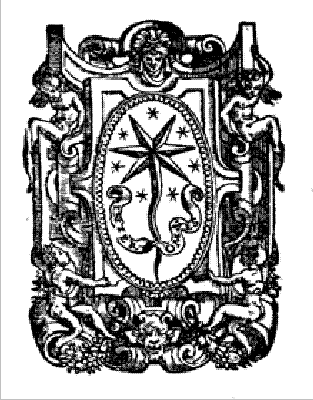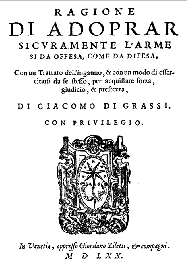
In Ered Sul, di Atenveldt, appresso HL Giacomo Cavalli di Treviso, & compagni.
AS XXXII
The Rapier and Dagger Fight
of Di Grassi and Saviolo
by William E. Wilson
Known in the SCA as Barwn Master Gwylym ab Owain, DWS

In Ered Sul, di Atenveldt, appresso HL Giacomo Cavalli di Treviso, & compagni.
AS XXXII
Both of the gentiles to be discussed were masters of fence during the Elizabethan period. While Saviolo had a school in England at the end of the period di Grassi taught in Italy earlier in the period and is more of a transitional master who taught a more thrust oriented fight albeit with the earlier style side sword (spada da lato).
Rapier and dagger play was quite prevalent on the continent and even in England during the Elizabethan period. Every gentleman carried a dagger and many carried rapiers. Due to this, a standard combination for duels was rapier and dagger. This style of fence was only used by masters playing their prize in London (according to all existing records). Below master level the rapier was rarely employed for the playing of prizes (London Masters of Defense).
The following is a brief synopsis of each master:
Grassi, Giacomo di
 Grassi
is called one of the three premiere Elizabethan masters that published
in English where the manuals are available today. He published his book
"His True Arte of Defense" in 1570 (in Italian) and 1599 (in English, although
it is doubtful that he still may have been alive at the time. The
date of his death is not known). Grassi analyzed lines of attack and defense
that have been used in fencing to the modern day. He has been called the
forefather of the smallsword and was one of the first masters of fence
to hint at using the sword to parry attacks. He also was a great proponent
of using the dagger as a defensive weapon.
Grassi
is called one of the three premiere Elizabethan masters that published
in English where the manuals are available today. He published his book
"His True Arte of Defense" in 1570 (in Italian) and 1599 (in English, although
it is doubtful that he still may have been alive at the time. The
date of his death is not known). Grassi analyzed lines of attack and defense
that have been used in fencing to the modern day. He has been called the
forefather of the smallsword and was one of the first masters of fence
to hint at using the sword to parry attacks. He also was a great proponent
of using the dagger as a defensive weapon.
Grassi began his section on rapier and dagger thus:
Having as briefly as I might possibly finished all that which might be saide, of true knowledge of single rapier: it seemeth convenient, that comming from the simple to the compound, I handle those weapons first, which from the Rapier forwards are either most simnple or least compound: And especially those which noweadays are most used, and in the which men are most exercised, the which weapons are the Rapier & Dagger accompanied togither, and are a great encrease and furtherance both in striking and defending.
Saviolo, Vincentio
Saviolo arrived in England from Padua in 1590. He is also considered one of the premiere Elizabethan masters. An eclectic, he taught a mixture of Italian and Spanish theory and practice. He also taught of the superiority of the thrust over the cut. His book "His Practice" covers honor as well as practical swordsmanship. He categorized cuts (similar to Marozzo) as well as thrusts. His moves (footwork) were more after the Spanish than the Italian style. He taught with Jeronimo in London.
Saviolo began his section on rapier and dagger thus:
That which I have heretofore shewed you, is but small in regarde of that I meane to teach you hereafter, so that having delivered you the manner of the single Rapier, you may the better concieve my discourse of the Rapier and Dagger, because it serveth much to the use thereof, and it shall not be necessary wholye to repeate the same, but I will onelye shewe you how to put your selfe in garde with your Rapier and Dagger, for if I desire to make a good scholler, I would my self put his Rapier in one hand, and his Dagger in the other, and so place his body in the same sorte, that I have before spoken of in the single Rapier, setting his right foot formost, with the point of his Rapier drawne in short, and the Dagger helde out at length, bending a little his right knee, with the heele of his right foote directly against the midst of the lefte, causing him to goe round toward the left side of his adversary in a good measure, that he may take his advantage, and then I would thrust a stoccata to his bellye beneath his dagger, removing my right foote a little toward his left side.
In short, there is much to learn from both styles and I would recommend that both be studied and techniques adapted from both of these fine masters.
The following is a breakdown of some of the differences:
Stance (positioning of the feet)
| di Grassi | Saviolo |
| First This stance is made with the right foot foremost.
Second This stance is made with the left foot foremost. |
Right foot foremost.
Body square to opponent (punta riversa) Left foot foremost. |
Wards (how one holds the weapons)
| di Grassi | Saviolo |
| High Ward
Broad Ward Low Ward |
Low Ward |
Attacks
| di Grassi | Saviolo |
| stocatta
imbrocatta reverse edge blow |
stocatta
imbrocatta punta riversa riversa mandritta stramazone |
There are numerous sources available for study these days. If you have access to the internet you may go to my Elizabethan Fencing home page at:
http://jan.ucc.nau.edu/~wew/fencing.htmlto access what I and others may have available.
Ciao!